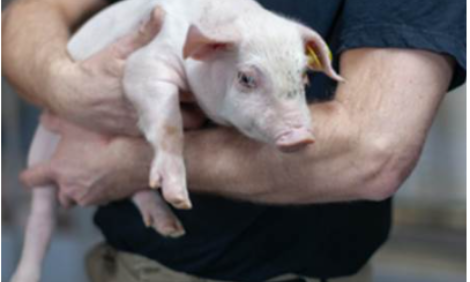



Lactation Failure in the Sow
Lactation failure or postpartum dysgalactia syndrome involves one or more of the following symptoms: mastitis, metritis and agalactia, infections of the udder and uterus and reduced milk production, respectively. Agnès Waret-Szkuta and Guy-Pierre Martineau of the Institut National Polytechnique-Ecole Nationale Veterinaire in France explain the causes, prevention and treatment in a factsheet for Pork Information Gateway.Introduction
Previously, lactation failure in swine was known as MMA (Mastitis, Metritis, Agalactia) syndrome. Now, it belongs to the Postpartum Dysgalactia Syndrome (PDS) and affects the optimum expression of the sows’ productive capacity in a way that is much less clinically visible. It is referred to as a syndrome to indicate that there may be several risk factors and clinical signs that are referred to collectively as lactation failure or, more exactly, an early and temporary dysgalactia, i.e. reduced or insufficient milk production. MMA can be seen as the emerging part of an iceberg represented by PDS, which is the more important and underestimated part and thus most dangerous. It is a major concern to pork producer because of the economic impact although it is difficult to quantify.
Associated problems are often considered separately (piglet diarrhoea, impaired piglet growth, parturition with hand help or use of antimicrobials or oxytocin). The clinical signs are very diverse as well as the importance individuals may attribute to them and a close observation of the piglets from problem litters will be more helpful for early detection than the observation of sows.
Commonly very early lactation failure affects 10 to 100 per cent of the sows. Sows affected produce insufficient colostrum and milk during the first days after farrowing.
In fact, the problem takes its root before farrowing although completely asymptomatic at that time and it will remain asymptomatic until piglets are affected. Producer intervention either at farrowing or treating piglets with antimicrobials should raise awareness on the possible occurrence of lactation problems of sows. This is because at farrowing, physiological priorities change from a pregnancy (foetus-orientated) to a high-milk-producing status. The transition is very complex and depends on an extensive series of biological adaptations that include many, perhaps most, body tissues and all types of nutrients. A slight asynchrony of these processes or unsuccessful transition may lead to PDS.
Clinical Signs
Clinical signs are many and varied depending on the herd. They are rarely all present at the same time or of similar intensity. Their sequence of appearance is also variable from one herd to another. They reflect that the origin of the cause may differ from herd to herd and is rarely unique.
Three closely related components that interact with one another have been highlighted and categorised to help the problem investigation after having been identified as potentially involved in the transition from a gestating to a lactating sow. They help explain the possible symptoms that can be observed either involving the sow but more often the piglets: the feed and feeding management, the presence of bacteria leading to the presence of toxins in blood and stress.
In sows, clinical signs may include low milk production (often reflected by a lighter than normal weaning weight), anorexia, hyperthermia but also hyper-reactivity, long farrowing duration (that may be unnoticeable at first because of the use of oxytocin or an increase in assisted farrowings). Discharge can sometimes be observed originating from bacterial toxins in the uterus.
If the primary site of infection is the mammary gland, the udder may appear enlarged, firm, warm, and more sensitive than usual, and often affected glands may appear discolored when compared to the rest of the udder. However, one must keep in mind that some hypogalactic sows will show little or no apparent signs of illness. Piglets will reflect the consequences of the sows’ disorders with stillbirth, diarrhoea, crushing and decreased weaning weight.
In addition, when managers observe the problem, they often introduce very strict rules before farrowing and the over-use of oxytocin or prostaglandins or the increase in assisted farrowings in order to control the problem.
Diagnosis
Diagnosis of PDS is not easy. Indeed, PDS reflects numerous different but interacting mechanisms that affect the optimum expression of the sows’ productive capacity in a way that is much less clinically visible than was the MMA syndrome.
However, it can be approached following identification of signs belonging to each of three components described above. It may also be important to identify susceptible sows. Prepartum loss of fat and in some cases muscles, frequent nowadays in hyperprolific females and carcass leanness appears to have a crucial impact on sows farrowing and post-partum; fat sows or very lean sows are predisposed to PDS. Primiparous (first litter) or older sows may have more difficulties coping in the change from pregnant to high-milk-producing.
The farrowing unit manager together with the gestation unit manager, nutritionist and veterinarian should work to characterise a particular situation and develop a programme of preventive action as quickly as possible.
Prognosis
The prognosis for the life of the affected sow or gilt is good; however, the prognosis for the reestablishment of normal lactation is guarded. Chilling, secondary diarrhoea and other neonatal diseases (such as crushing) decrease the chances for survival of individual piglets. In the most extreme cases of MMA, the affected sow usually recovers in two to five days with or without return of lactation. Culling the sow should be considered if she has several hard, non-functional mammary glands after recovery. Unless lactation is rapidly reestablished or supplemental feeding is successful, the chances for piglet survival are low.
At the herd level, prognosis is a function of identifying the contributing causes. Increasing attention to gilt preparation, feed and feeding of the sows, stress management and defining carefully ‘need to treat infection’ thresholds should help correct and prevent PDS in the future.
Treatment
Although treating individuals can be rewarding, prevention will most probably be more dependent on a good gilt development programme. Thus, events that occur two or three days before farrowing related to hormonal level changes, for example, interfere with events occurring after farrowing and colostrum production. However, supplemental heat for the piglets during the first few days is energy conserving to them and can aid survival. Cross-fostering to lactating females may be a temporary solution particularly for those most affected.
Controlling cystitis, mastitis and/or uterine infection should also be included in the treatment strategy. A purulent discharge (pus) from the vulva does not necessarily indicate that the sow or gilt has a uterine infection (metritis). Although studies have revealed that over 60 per cent of clinically normal sows have vulvar discharge for 24 to 36 hours, this discharge is not correlated with impaired piglet growth. Discharge that persist past 36 hours often are accompanied by decreasing thrift of the litter and indicate a need to examine and treat the sow.
Prevention
Prevention should centre on herd health management, water and nutrition and tackling the three pathways with a prominent role in the occurrence of lactation failure. Efforts to reduce stress throughout gestation, especially near parturition, are important preventive measures. An example would be sow acclimatisation to the farrowing facility, especially the water distribution system.
Low water intake in gestation is a common risk factor for cystitis (inflammation of the bladder) and, secondarily, for post-partum uterine infection. Inadequate water intake just before farrowing may also lead the sow to conserve water at the expense of the water content of the intestine, leading to constipation.
Nutritional disorders are a significant factor in the development of PDS. Feeding levels all along the sow production cycle from before gestation to the time of farrowing and during lactation have an influence on the incidence of dysgalactia. Level and quality of fibre and protein are important factors to consider.
Attention to farrowing house environment is critical. Maintenance of clean, dry floors during gestation and parturition can reduce bacterial populations and thus reduce udder or uterine infections.
Preventive efforts using various drugs and hormones (fed and/or injected) prior to farrowing have occasionally produced excellent results. However, critical evaluations and continued study indicate that what works in one herd may have no value in another herd or may even have adverse consequences.
Further Reading
Find out more information on Postpartum Dysgalactia Syndrome (PDS) by clicking here.
February 2015








